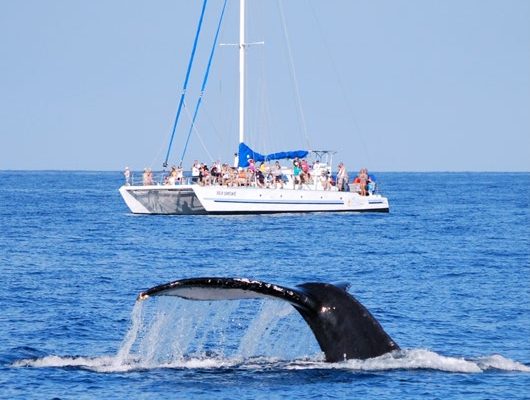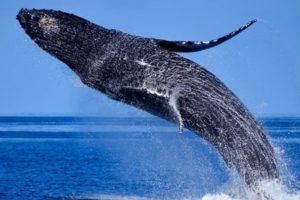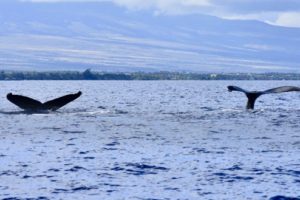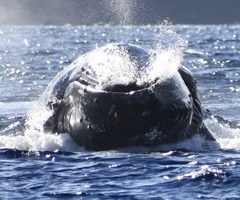Whale Watch 2022
The annual return to Hawaiian waters of the humpback whales — named for the motion the big mammals make as they arch their backs out of the water in preparation for a dive — is one of the most anticipated times in the islands, both for visitors and for residents. When we see the spouting, tail slapping, and athletic, full-body leaps from the water, even the locals stop by the side of the road, or pause what they’re doing to watch.
It’s painful to consider, but these gentle giants who visit Hawai`i between November and March were once hunted close to extinction by whalers. The practice was sustainable — even if repulsive by today’s standards — through the 1850s and ‘60s. But once explosive harpoons were introduced in the late 19th century, the kill rate increased dramatically, and consequently the population of humpback whales saw a sharp decline.
Visit Ocean Sport website for more information or to book a whale watch cruise. Ocean Sports offers “Guaranteed Whale Watch Cruises.” If you don’t see a Humpback during your cruise, you can go out with them for FREE until you do!
Nowadays there are an estimated 140,000 humpback whales in the world’s oceans. Their encouraging recovery was largely brought about when the International Whaling Commission gave the humpbacks protected status in 1966. Still, the number is only 30 35 percent of the species’ former population; and while stocks have partially recovered, today’s challenges include entanglement in fishing gear, collisions with ships, and noise pollution associated with sonar blasting the U.S. Navy was conducting until an agreement limiting the practice was reached several years ago.
A typical adult humpback weighs 40 tons, and lives 45-70 years. During their annual migration from summer feeding grounds near the poles to warmer winter breeding waters closer to the Equator, they travel some 3,100 miles at speeds of three to nine mph. They can travel up to 1,000 miles per month.
One of the best ways to learn more about and watch the whales more closely is through a whale watch cruise, offered at Waikoloa Beach Resort by Ocean Sports, a company that has been working in Hawai`i since 1981. We asked Claire Muchin, a consultant and naturalist on the Ocean Sports boats, to share some insights on the humpbacks.
MUCHIN: Yes — most years the Humpbacks seem to show up off the Kohala Coast right around Halloween. This year, the first Humpback spotted around any of the Hawaiian Islands was off the coast of Hana in Maui on October 1st.
MUCHIN: Well, we always hope so, but the whales get to make that decision.
MUCHIN: The Humpbacks that come to Hawai`i are part of the North Pacific population (there are 14 distinct populations who live in each of the world’s oceans). Of the approximately 20,000 22,000 North Pacific Humpbacks, about two-thirds come to Hawai`i. The rest migrate to waters off of Baja California or the Southern Islands of Japan. For the most part, the humpbacks that come to Hawai`i migrate directly north and spend their summers off the coast of Alaska (from the Gulf of Alaska to the Aleutian Islands). Migration to Hawai`i from Alaska begins in autumn. Interestingly, individual humpbacks will not spend an entire winter here. They may spend as little as two weeks here before heading back … and if a female mates successfully on the way to Hawai`i, she may turn around and swim back to Alaska without even reaching the islands.
MUCHIN: Humpbacks are the whales who migrate here, but as many as 18 different species of cetaceans live around the islands yearround. We encounter some of them frequently (like spinner dolphins), though most of the others live in deeper water (like sperm whales). But we do see some species like melon head whales, spotted dolphins, false killer whales, and pilot whales on occasion in the coastal waters.
MUCHIN: A lot of researchers are looking into this right now and most seem to agree that it’s the availability of the Humpbacks’ prey sources that most affect migratory patterns and the health of the population in general. If the small fish our Hawaiian Humpbacks feed upon in Alaska during the summer months aren’t abundant, the Humpbacks may end up spending less time away from the food sources during the winter months (maybe because they don’t have the blubber stores to sustain them), which could mean a shorter breeding season overall.
MUCHIN: Some researchers have noted that when the prey sources are depleted, fewer calves are observed. It may mean that breeding females aren’t as fertile, or receptive — or maybe they aren’t migrating away from the feeding grounds for as long a time period — which would result in fewer available breeding females in Hawaiian waters. Since Humpbacks don’t seem to eat during the breeding season, anything that affects the health and abundance of their food sources in Alaska will ultimately affect their behaviors here in Hawai`i.
MUCHIN: We try to get our guests involved in the excitement of seeing the Humpbacks and sharing the ocean with them. We’ve found that Humpbacks themselves are the ones sharing the important messages..
MUCHIN: Well, we know that Spinner Dolphins (Stenella longirostris) spend the nighttime hours out in deep water feeding on the vertical migration of small fish, shrimp, and squid, so by the time they arrive back to the shallow waters where humans generally encounter them, the dolphins need to rest. The Spinners seem pretty curious about boats and other objects — including people — in the water, so when they echolocate, hear, or see us, they often swim closer to investigate, which certainly disrupts their resting time. Hopefully, NOAA’s recent ban on interactions closer than 50 yards to the dolphins will allow the dolphins to get the rest they need to stay healthy.




